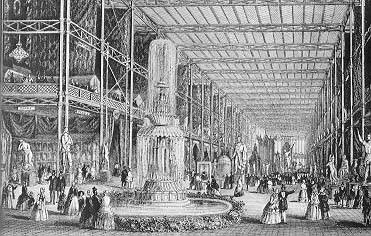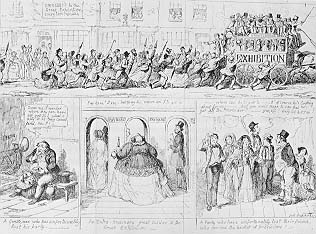When we speak of Victorian complacency or stability or optimism, we
are usually referring to this mid-Victorian phase--"The Age of Improvement,"
as the historian Asa Briggs has called it. "Of all the decades in
our history," writes G. M. Young, "a wise man could choose the eighteen-fifties
to be young in."
| In 1851 Prince Albert opened the
Great Exhibition (right) in Hyde Park,
where a gigantic glass greenhouse, the Crytal Palace, had been erected
to display the exhibits of modern industry and science. The Crystal
Palace was one of the first buildings constructed according to modern architectural
principles in which materials such as glass and iron are employed for purely
functional ends (much late Victorian furniture, on the other hand, with
its fantastic and irrelevant ornamentation, was constructed according to
the opposite principle). |

|
| The building itself, as
well as the exhibits, symbolized the triumphants feats of Victorian technology.
Pride in technological progress,
however, is only one element of the mid-Victorian period. Equally
significant is the conflict between religion
and science. e.g. Tennyson's "In
Memoriam."
|
 The caption reads: Odds and Ends, in,
out, & about, The Great Exhibition of 1851.
(Bentley 105)
The caption reads: Odds and Ends, in,
out, & about, The Great Exhibition of 1851.
(Bentley 105)
|
(Norton Anthology
pp. 895-896) |